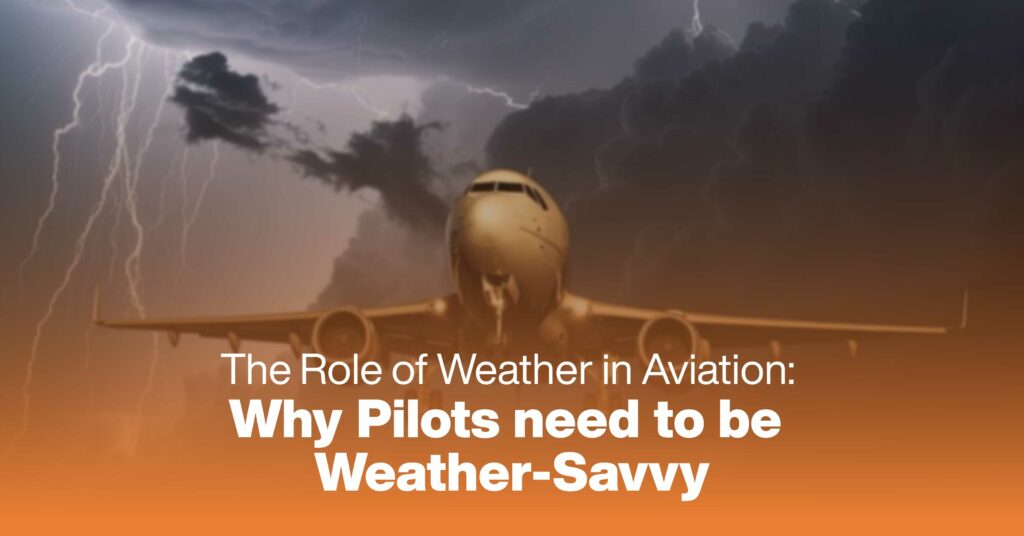Weather plays a crucial role in aviation, impacting flight operations and safety. Pilots need to be weather-savvy to ensure the well-being of passengers and crew, as well as the successful completion of flights. In this article, we will explore the basics of weather in aviation, its impact on flight safety, tips for flying safely during unpredictable weather, and how Garg Aviations can help pilots in this regard.
Weather Basics For Aviation
Understanding weather basics is essential for pilots. Weather conditions such as temperature, wind speed, and atmospheric pressure can significantly affect aircraft performance and handling. Pilots must be familiar with meteorological terms, weather charts, and forecasts to make informed decisions before and during flights. By staying updated on weather developments, they can plan and adjust their routes accordingly to ensure a smooth and safe journey.
Weather’s Impact On Flight Safety
Weather can have various impacts on flight safety. Let’s explore the four main types:
1. Turbulence
Turbulence is one of the most common weather-related hazards that pilots encounter. It refers to sudden changes in air movement, causing the aircraft to shake or jolt. Severe turbulence can pose risks to the safety of passengers and crew, as well as damage the aircraft. Pilots must be able to anticipate and navigate through turbulent regions to minimize potential harm.
2. Poor Visibility
Fog, rain, snow, or dust storms can decrease visibility, making it challenging for pilots to see and navigate properly. Low visibility increases the risk of collisions with other aircraft or obstacles on the ground. Pilots rely on advanced navigation systems, weather radar, and air traffic control guidance to ensure a safe flight during these conditions.
3. Strong Winds
Strong crosswinds, downdrafts, or updrafts can affect the stability and control of an aircraft. Pilots need to be skilled in handling such conditions to avoid accidents or loss of control. They receive extensive training on crosswind landings and takeoffs to ensure the safety of everyone on board.
4. Thunderstorms
Thunderstorms pose significant risks to aviation. They can generate powerful updrafts and downdrafts, severe turbulence, hail, lightning, and heavy rain. Pilots need to carefully navigate around or through thunderstorms, using weather information and radar systems to identify their intensity and potential threats. Deviating from the storm’s path is crucial to maintaining flight safety.
Tips To Fly Safely During Unpredictable Weather
Flying during unpredictable weather requires extra precautions. Here are some essential tips for pilots:
1. Stay Informed: Regularly check weather briefings, forecasts, and updates from meteorological sources or flight operations departments.
2. Use Advanced Weather Radar: Equip the aircraft with weather radar to detect and avoid severe weather cells.
3. Plan Alternate Routes: Have alternate flight paths in mind to divert from areas with adverse weather conditions.
4. Maintain Communication: Stay in touch with air traffic control and fellow pilots to exchange weather-related information and updates.
How Garg Aviations Can Help?
Garg Aviations understands the importance of weather in aviation and provides comprehensive weather services to assist pilots. They offer real-time weather updates, tailored forecasts, and advanced radar systems to enhance flight safety. With Garg Aviations, pilots can access accurate and reliable weather information, enabling them to make informed decisions and ensure the well-being of everyone on board.
Frequently Asked Questions
1. Why is weather information crucial for aviation?
Weather information is crucial for aviation as it helps pilots anticipate and navigate through hazardous conditions, ensuring the safety of passengers, crew, and the aircraft. It allows for effective flight planning and timely decision-making.
2. How do pilots obtain weather information before a flight?
Pilots obtain weather information before a flight through various sources such as meteorological reports, weather briefings, online weather services, aviation weather apps, and communication with air traffic control.
3. What are the main weather factors that affect aviation?
The main weather factors that affect aviation include turbulence, poor visibility, strong winds, thunderstorms, icing conditions, and extreme temperatures.
4. Can bad weather lead to flight delays or cancellation?
Yes, bad weather conditions can lead to flight delays or even cancellation. Safety is the top priority in aviation, and adverse weather conditions can make flying unsafe or impractical.
5. How do pilots handle adverse weather conditions during a flight?
Pilots handle adverse weather conditions during a flight by relying on advanced weather radar, following air traffic control instructions, deviating from dangerous weather cells, and utilizing alternative routes when necessary.
Conclusion
Being weather-savvy is an essential skill for pilots to ensure the safety and efficiency of flight operations. By understanding weather basics, identifying its impact on flight safety, and following tips for flying safely during unpredictable weather, pilots can navigate through challenging conditions with confidence. With the support of Garg Aviations’ weather services, pilots can access accurate and timely information to make informed decisions, ultimately keeping everyone on board safe.

